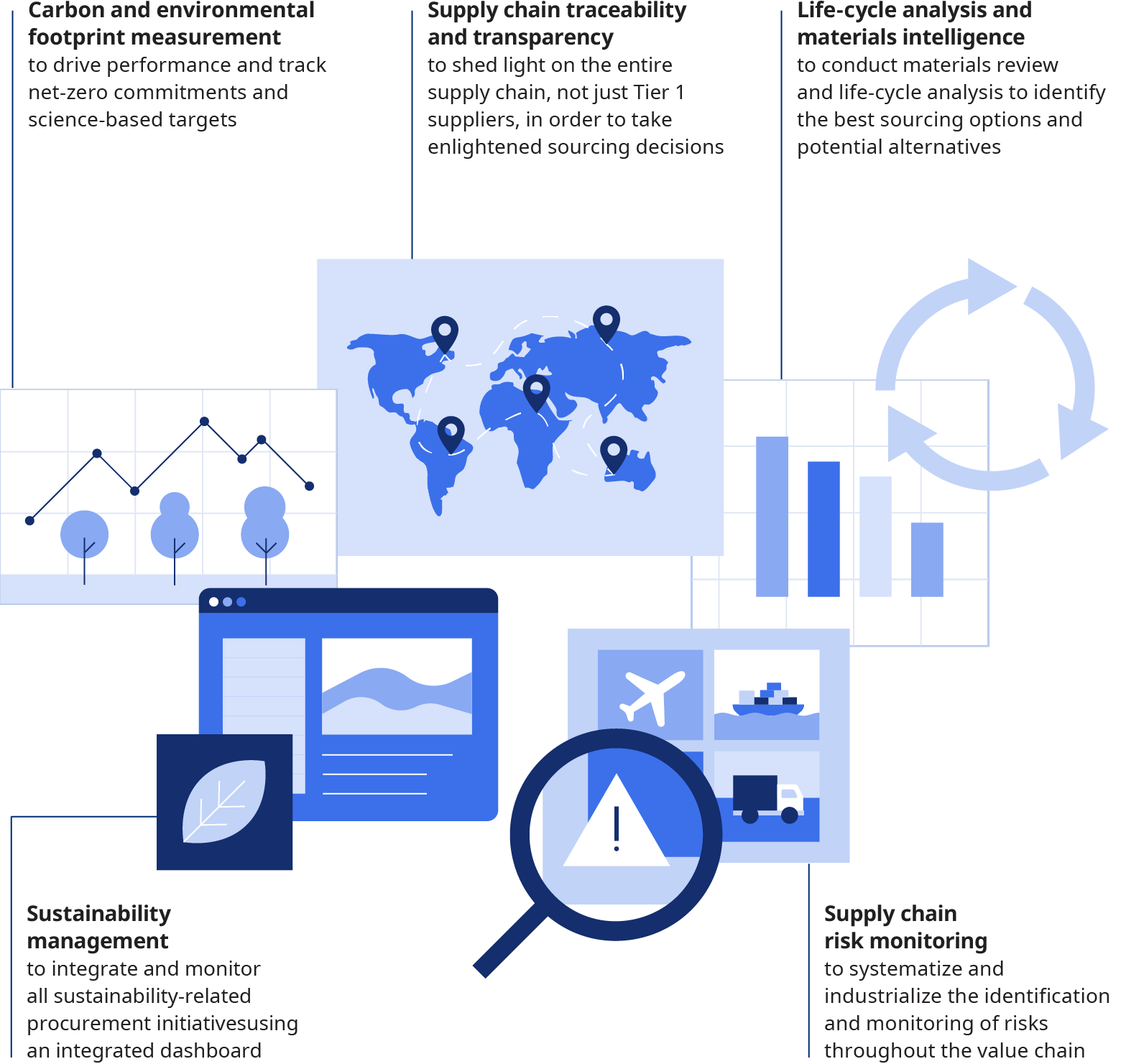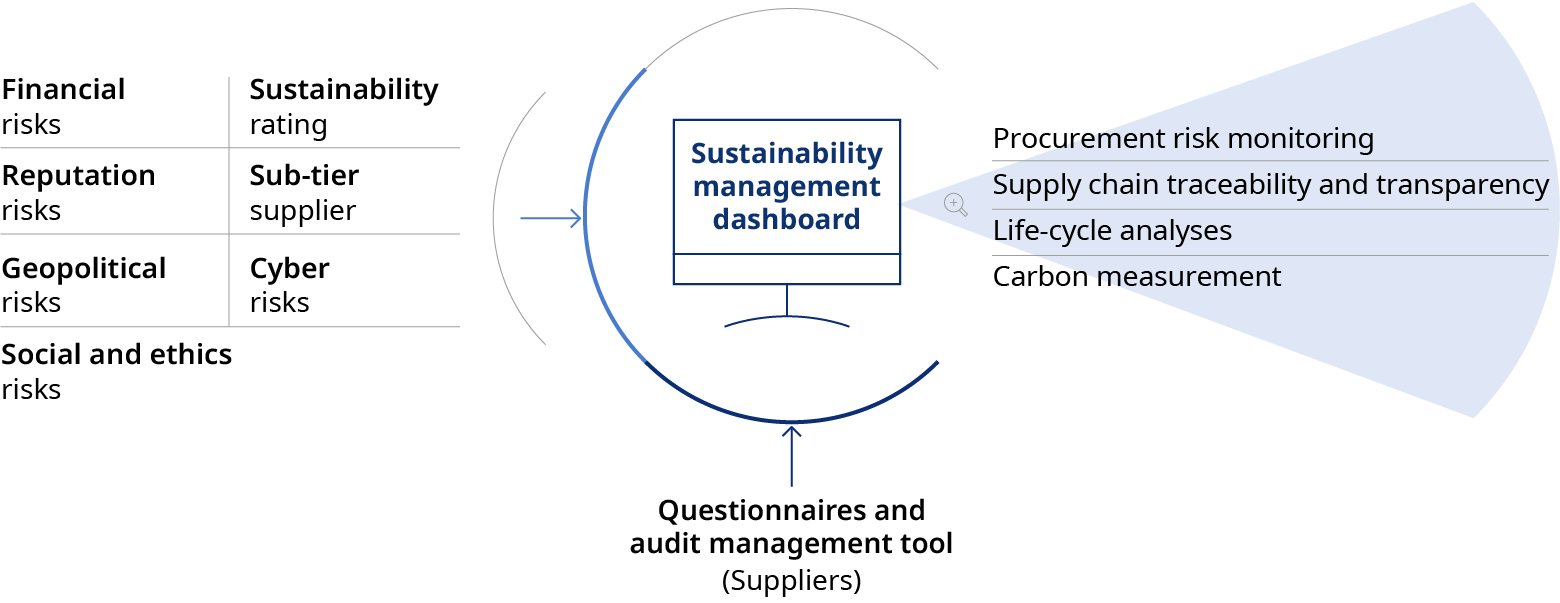Our latest Sustainable Procurement survey of 300-plus chief procurement officers worldwide highlighted a growing momentum in implementing environmental, social, governance (ESG) topics. Four out of five companies now report that they have started to convert their sustainability ambitions into procurement objectives. Increasingly, procurement is being mobilized to help meet the targets of the sustainability roadmap.
In our previous paper, we focused on how to reinvent procurement performance monitoring to track progress in meeting sustainability targets. That paper explored the different approaches for doing so, comparing the use of aggregated ratings with granular indicators. This article explores the options available for crafting the digital asset strategy needed to embed ESG in procurement data. This choice is critical to determining the effectiveness of monitoring.
How to use frameworks and tools for sustainable procurement data
In our judgement, no company should seek to manage single-handedly all the data required to monitor progress in sustainable procurement. The quantity and complexity of data involved can be overwhelming. Fortunately, industry frameworks and alliances, when combined and integrated with data tools available in the ProcureTech marketplace, can help make this task more readily manageable.
It has been assumed that procurement has not only already adapted the corporate sustainability objectives and targets to the purchasing and supply chain realm but has also prioritized these objectives in terms of those most critical to sustainability in each purchasing category. This being done, the next task is to start identifying the necessary digital assets required to fulfil the monitoring requirements.
Identify the most appropriate tools for powering your sustainable procurement strategy
First a home truth. There is no point in seeking the perfect tool or digital suite. Currently, there is no such tool. The place to start your journey is by defining the exact needs you wish to address, and then selecting and integrating various digital assets that, collectively, can meet these needs. Most tools will address one specific angle or issue. Today’s ProcureTech landscape can be loosely grouped into five categories: supply chain traceability and transparency; lifecycle analysis and materials intelligence; carbon and environmental footprint measurement; supply chain risk monitoring; and sustainable management. (Exhibit 1).

There are many more choices within each of the five categories. For instance, a number of tools are tailored to one product or industry, such as, focusing on the traceability of plastic materials, the food industry, or on materials origin in the fashion industry. While such tools cannot be customized to meet the needs of individual companies, they still provide a powerful resource when their scope aligns with your challenge. In addition to individual tools, a number of companies provide digital suites.

The leading digital platforms all offer sustainability add-ons for their software suites; some are even beginning to provide interfaces to other tools. Despite the growing level of flexibility and customization, none of these integrated suites are currently as powerful in their features as what can be achieved by creating your own solution by drawing together various tools available in the market.
Build your own capabilities to serve specific needs
Despite the wide range of ProcureTech tools available today, they cannot meet every need of every company. If this proves to be true in your case, you might need to consider building your own in-house solution. A word of warning: doing so will inevitably prove challenging and will add cost. Another risk is that in-house solutions often prove suboptimal even after significant investment. As one leader in sustainability in the consumer goods space commented, this risk cannot be mitigated entirely. Data gathering, storage and use is currently not sufficiently mature in any company.
Three golden rules to reduce complexity in defining the right digital asset strategy
While in-house development is always challenging, these following rules can reduce the complexity of the task.
- Let your supplier own the data
Although you need to define the nature of the data to be collected, including its scope, the rules to be followed and the timeframe for collection, as well as the methodologies and the means for doing so, your suppliers’ role will nevertheless be absolutely critical in achieving these things. It is the supplier who will be responsible for collecting, streamlining, packaging and sending the data to you. It is vital to ensure that this process is manageable both for you and for them. We have seen too many companies ask for too great a quantity of poorly defined data, in the hope that somehow this data dump might provide something valuable. All too often, this leaves the company at a loss, weighed down in complexity. Keep things well-defined and simple. - Invest upfront by collaborating with suppliers
Work collaboratively with your suppliers to ensure that the baseline, calculation, collection process, and controls are clear and implemented in year one. This is an essential step prior to industrializing the process in subsequent years. While such an approach might at first glance seem more expensive and elaborate, it will ultimately prove less costly than discovering two or three years down the road that the data set is not fit for purpose and so requires reengineering to mitigate problems. For remote locations or complex supply chains, for example, we have seen many leaders training local third parties, such as consultants or the auditors, so that these parties can in turn train and manage the local suppliers. - Rely on existing initiatives and leverage industry frameworks
Even when you need to consider building your own solution from scratch, it is always valuable nonetheless to rely wherever possible on existing industry frameworks, alliances, and ecosystems. Sustainability is always more effective when industry peers combine their efforts. Where no frameworks or alliances exist, you might need to start building one in order to bring alignment around industry data sets and sustainability targets. Ultimately, the goal is to drive concerted change across the supply chain.
As you near the end-state in your digital asset journey, you might consider gathering and orchestrating all your assets into a central dashboard for sustainable procurement — we have seen some leaders create very powerful examples. This can provide senior management with an instant overview of the state of progress in achieving the company sustainability goals.


